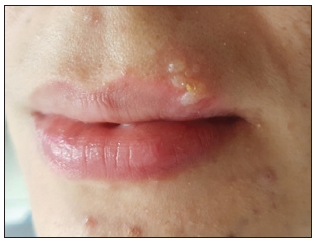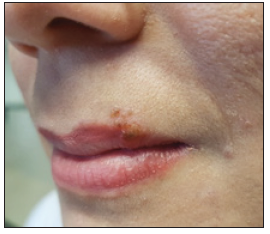- Submissions

Full Text
COJ Reviews & Research
How to use Photobiomodulation and Photodynamic Therapy to Treat the Herpes Simplex Labial Vírus?
Andréa Dias Neves Lago*, Daniele Meira Conde Marques, Guilherme Silva Furtado and Letícia Machado Gonçalves
Department of Dentistry, Federal University of Maranhão, Brazil
*Corresponding author: Andréa Dias Neves Lago, Department of Dentistry, Federal University of Maranhão (UFMA), Av. dos Portugueses, 1966, Bacanga - São Luís - MA, Brazil
Submission: February 10, 2020; Published: February 14, 2020

ISSN 2639-0590Volum2 Issue4
Abstract
The morbidity evolution is uncertain. Not only in relation to the most obvious relationships, such as the evolution of bacterial resistance to antibiotics or genetic susceptibility to disease. Rather, this evolution of diseases over time and between countries is not explained in biologic changes but in contextual changes. And technological changes work to our advantage, but also to our detriment. There is a creation of new diseases, which result in giving pharmacological treatments for minor problems, increasing concern about future diseases in healthy populations, and converting personal and social problems into diagnosable health disorders and in need of pharmacological treatment. There is a medicalization of symptoms and risk factors. There is a recruitment of a greater number in diagnoses of chronic diseases through new detection and diagnosis technologies and the new disease definitions, as well as the equalization of risk factors with disease. It leads to overdiagnosis, over-treatment, multimorbidity and polypharmacy. This brings a dramatic increase in adverse drug reactions and drug-drug interactions. It is admitted that the mechanism due to causation, associations and links between diseases accounts for half of the reasons for accumulation of diseases, but the mechanism for iatrogenesis and complication accounts for another 10% of the causes of accumulation of diseases. Although it has long been known that the most important relationship on health is in psychosocial factors, current bio-technological evolution leads a new theory that complements the previous: multimorbidity and disease in general, in a small part but significant, can be created by the medical intervention itself. But it must bear in mind, that this mechanism could be prevented, so the presence of multimorbidity is not a natural and forced consequence of nature.
Keywords: Health care; Health expenditures; Drug-related side effects and adverse reactions; Overdiagnosis; Multimorbidity; Polypharmacy
Introduction
In the manifestation of the herpes simplex labial virus, the 3 clinical periods of the disease can be distinguished: prodromal, active clinical (or vesicular) and reparative (or healing) [1,2]. Herpes labialis usually has a prodromal period lasting a few hours up to 4 days, which includes local itching associated or not with burning and pain, and may also include fever, anorexia, irritability, malaise, drowsiness and headache [1-4]. The vesicular phase corresponds to the presence of vesicles full of viruses that, after a few days, can unite and rupture [5]. The lesions involve the oral mucosa, tongue, gums, hard palate and pharynx, with the lips and perioral skin being affected in 2/3 of the cases. Cycles have a duration of 7 days in mild cases, and 14 to 21 days or more in more severe cases [1,6]. It is the most contagious phase of the virus and it is important that we find a way to contain the virus.
Photodynamic Therapy (PDT) has been used in dentistry as a new alternative for the treatment of herpes in this vesicular phase [7,8], consisting of the application of a photosensitive dye and the use of laser light at the red wavelength to achieve the desired effect: In this case, the antimicrobial and destructive action of viruses. Photo biomodulation therapy, on the other hand, is used in lesions in the crust phase for causing a stimulus in the microcirculation, causing vasodilation of arterioles and capillaries and for vascular neoformation, thus leading to an increase in blood flow in the irradiated area [1]. Thus, it is used to heal various tissues, as it stimulates an increase in the production of cellular Adenosine Triphosphate (ATP), causing acceleration in cellular mitotic activity [4].
Accelerating the healing period. The patient attended the laser clinic at the Federal University of Maranhao complaining of the vesicles on the upper lip on the left side (Figure 1). After the diagnosis of herpes simplex labial, the vesicles were drained carefully and the methylene blue 0.005% was applied (Chimiolux, DMC, São Carlos, SP, Brazil) (Figure 2) and then irradiation with the low-level laser power (606nm, 100mW, 3J, 30s per point in 6 points) (Figure 3).
Figure 1: Initial appearance. Vesicular phase of the clinical manifestation of the herpes simplex virus.

Figure 2: Application of the methylene blue photosensitizer 0,005%.

Figure 3: Low power laser irradiation (Laser Therapy XT, DMC, São Carlos, SP, Brazil).

After 24 hours of photodynamic therapy, the patient was no longer in the contagious phase, as the viruses were inactivated and now the clinical manifestation was in the crust phase (Figure 4), starting photo biomodulation therapy to reduce the healing time. Thus, the laser is an excellent option for treating the clinical manifestations of the herpes simplex labialis virus, both in the vesicle phase using photodynamic therapy and, in the crust, phase using photo biomodulation therapy to accelerate the healing time. In the prodromal phase, photo biomodulation therapy can also be used to relieve symptoms and, in most cases, it does not evolve into the vesicular phase.
Figure 4: Aspect 24 h after photodynamic therapy. Observe the crust aspect

References
- Lago ADN, Furtado GS, Ferreira OC, Diniz RS, Gonçalves LM, et al. (2018) Resolution of herpes simplex in the nose wing region using photodynamic therapy and photo biomodulation. Photodiagn Photodyn Ther 23: 237-239.
- Ramalho KM, Rocha RG, Correa AAC, Cunha SR, Simões A, et al. (2015) Treatment of herpes simplex labialis in macule and vesicle phases with photodynamic therapy. Report of two cases. Photodiagn Photodyn Ther 12(2): 321-323.
- Honarmand M, Farhadmollashahi L, Vosoughirahbar E (2017) Comparing the effect of diode laser against acyclovir cream for the treatment of herpes labialis. J Clin Exp Dent 9 (6): e729-32.
- Bello Silva MS, de Freitas PM, Aranha AC, Lage MJL, Simões A, et al. (2010) Low- and high-intensity lasers in the treatment of herpes simplex vírus 1 infection. Photomed Laser Surg 28(1): 135-139.
- Sperandio FF, Marotti J, Aranha AC, de Paula CE (2009) Photodynamic therapy for the treatment of recurrent herpes labialis: Preliminary results. Gen Dent 57(4): 415-419.
- Crimi S, Luca F, Alberto B, Cesare DA, Giulia A, et. al. (2020) Herpes Virus, Oral Clinical Signs and QoL: Systematic Review of Recent Data. Viruses 11(5): 1-18.
- de Paula CE, Aranha AC, Simões A, Bello MSS, Ramalho KM, et al. (2014) Laser treatment of recurrent herpes labialis: A literature review. Lasers Med Sci 29(4): 1517-1529.
- Marotti J, Sperandio FF, Fregnani ER, Aranha AC, de Freitas PM, et al. (2010) High-intensity laser and photodynamic therapy as a treatment for recurrent herpes labialis. Photomed Laser Surg 28: 439-444.
© 2020 Andréa Dias Neves Lago. This is an open access article distributed under the terms of the Creative Commons Attribution License , which permits unrestricted use, distribution, and build upon your work non-commercially.
 a Creative Commons Attribution 4.0 International License. Based on a work at www.crimsonpublishers.com.
Best viewed in
a Creative Commons Attribution 4.0 International License. Based on a work at www.crimsonpublishers.com.
Best viewed in 







.jpg)






























 Editorial Board Registrations
Editorial Board Registrations Submit your Article
Submit your Article Refer a Friend
Refer a Friend Advertise With Us
Advertise With Us
.jpg)






.jpg)













.bmp)
.jpg)
.png)
.jpg)














.png)

.png)



.png)






